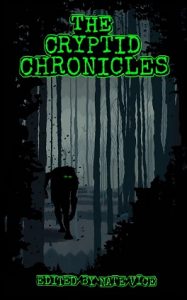
© DBND Publishing
Jim Mountfield, the penname under which I write horror fiction, has just had a third short story published in 2021. The story is called When the Land Gets Hold of You and appears in an anthology from editor Nate Vice and DBND Publishing called The Cryptid Chronicles. As its title indicates, the stories in the collection all concern cryptids, that pseudoscientific category of animals that some people claim to exist but nobody has ever conclusively proven to exist. Among the more famous examples of cryptids are Chupacabra, the Jersey Devil, Nessie and Sasquatch.
In When the Land Gets Hold of You, a storm knocks over an ancient oak tree on a Scottish farm and the hole created by its torn-up root system releases some unfriendly creatures from centuries of hibernation. The creatures are modelled on the fairies found in Scottish folklore. And as the story’s main character points out: “Fairies only became domesticated in Shakespeare’s time. He wrote A Midsummer Night’s Dream, which turned them into the Walt Disney beings we know them as today.” But before Shakespeare: “…humans feared and despised them… you can’t deny what’s in those old legends. Fairies were feared. People were terrified of them.”
The creatures in When the Land Gets Hold of You are actually inspired by two types of Scottish fairy. Firstly, redcaps were supposed to lurk in the peel towers that were built near the southern Scottish border to guard against invading armies from England. The most notorious redcap is the one associated with the dark, oppressive Hermitage Castle in Roxburghshire. According to legend, William de Soulis, son of the castle’s founder, Sir Nicolas de Soulis, practised the dark arts and employed a creature called Robin Redcap as his familiar. Robin Redcap was a hideous being. In his book about the mythical beasts of Scotland Not of this World (2002), Maurice Fleming describes him as “a thick-set old man with fierce red eyes, long tangled hair, protruding teeth and fingers like talons.”
Also providing inspiration is the brownie, which is actually supposed to be a benevolent fairy because it performed chores around households and farms while the human occupants were asleep. However, if you visit Glasgow’s Kelvingrove Art Gallery and Museum, you’ll see a famous painting by Edward Atkinson Hornel called The Brownie of Blednoch (1889), which portrays the brownie of the title as a grotesque thing with grey-brown skin, pointed ears, a crooked mouth, eyes that resemble poached eggs and a beard that’s as long, swirling and tentacled as an octopus. That said, even the monstrous-looking brownie in the painting is shown performing a service, which is guarding the local shepherds’ flocks at night-time.
In recent years, filmmakers have cottoned on to the notion that fairies and their associated lore provide promising material for horror movies. Alas, the two horror films I’m thinking of, The Hallow (2015) and The Hole in the Ground (2019), both of which were Irish and used fairies as their ‘monsters’, were disappointing and missed opportunities in my opinion. Much better are a handful of short stories by the underrated Scottish writer Dorothy K. Haynes. Changeling, Paying Guests and The Bean-Nighe all feature malevolent fairies and appear in her excellent 1949 collection Thou Shalt Not Suffer a Witch.
Offering 199 pages of chilling, cryptid-orientated entertainment, The Cryptid Chronicles can be purchased here.

